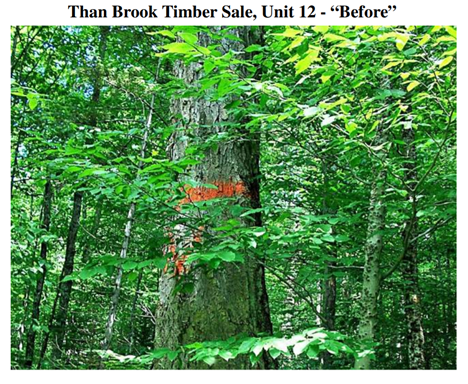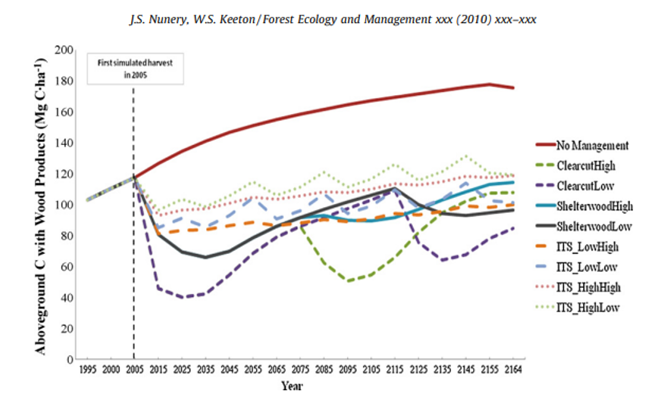By KRIS PASTORIZA
The U.S. Forest Service (USFS) proposes to log 880 acres and reconstruct 5+ miles of roads on White Mountain National Forest (WMNF) land around Lake Tarleton in Warren and Piermont, New Hampshire. Lake Tarleton, the largest lake in the National Forest, is a little-known jewel, and the maturing forest around it contains the rich historic area of Charleston, one of the many abandoned towns in New Hampshire,
Because the WMNF leaves the areas designated as Wilderness, under the National Wilderness Act, and the popular hiking areas alone, most visitors to the White Mountains are spared the sight of the many clear and “selective” cuts on the balance of the forest, and thus WMNF avoids the large opposition its logging practices deserve. These unprotected forests are subject to relentless logging, justified by management plans driven by economic/political power rather than science.
The climate emergency and sixth mass extinction have not lessened the commitment of those driving these policies to enrich themselves or others at the expense of the future. Some Forest Service and Park Service employees know ‘their’ management practices are contributing to these disasters. As a Bureau of Land Management (BLM) manager said: ““I know I’m breaking the law, but if I followed the law, I’d have every county commissioner, state legislator, governor and Congressional member in my state trying to get me fired. You’re not paying me enough to go through that. I rely upon the environmental groups to sue me and then when I lose in court, I can say, ‘Hey I don’t want to do this, but the courts and environmentalists are making me do this.’” 1
For the Forest Service, Lake Tarleton is a resource, an object required to serve the economic/political Forest Plan by producing “high quality forest products” and providing “a diversity of habitats,” though the data supports neither of these goals as ecologically sound.
The Tarleton Integrated Resource Project Draft Environmental Assessment does not consider logging’s cumulative contribution to global warming, its compaction of soils, its prevention of old growth, the effect of the noise of skidders and feller-bunchers on wildlife and abutters or the impacts of logging on forest and water quality, including increased runoff of mercury in soils. Lake Tarleton, like almost all New Hampshire lakes, is contaminated with mercury. Loons nest in Lake Tarleton. William Little, in his 1870 ‘History of Warren’, wrote of a Great Northern Diver in Lake Tarleton. “Loons in New Hampshire have among the highest concentrations of mercury recorded in loons anywhere in North America.” The Lake Tarleton Draft Environmental Assessment does not contain the word mercury.
Even in a purely economic assessment, the value of the forest left standing far exceeds that of the timber and hunting products WMNF logging subsidizes. To provide mature forests that will slow global warming and the sixth extinction, at least 30% of the planet needs to be protected by 2030, and 50% by 2050. “…proforestation (letting trees grow) is the lowest cost opportunity for reaching the zero net carbon goal by 2050.”


(above and below:) http://www.maforests.org/WMNF.pdf
Aboveground carbon stores are greatest in un-managed (un-logged) forests:
The language of forest managers is designed to misrepresent the facts.
It is time for the United States Forest Service to serve the White Mountain National Forest and the biosphere rather than economic/political interests who have “captured” the deciders.
A small but dedicated group of business and private interests has formed The Lake Tarleton Coalition.
They are working hard to stop the logging and road work and they can use all the help they can get.
Support The Lake Tarleton Coalition.

Kris Pastoriza
Easton, N.H.
(1) Quoted by Christopher Ketcham: https://www.thedailybeast.com/help-wanted-biologists-to-save-
the-west-from-trump?ref=author
USFS Lake Tarleton documents:
Forest Carbon Assessment: https://www.fs.usda.gov/nfs/11558/www/nepa/111828_FSPLT3_5657677.pdf
Logging Plan: https://www.fs.usda.gov/nfs/11558/www/nepa/111828_FSPLT3_4863704.pdf
Wildlife and Habitat Features map: https://www.fs.usda.gov/nfs/11558/www/nepa/111828_FSPLT3_5036641.pdf
Mass AG Presentation: The Critical Role of Forests in Protecting Climate Health: https://www.youtube.com/watch?v=IjAQsqACuWU
Data indicating that logging increases mercury concentrations in water bodies:
https://www.mdpi.com/1999-4907/12/9/1278/htm 2021
https://www.ncbi.nlm.nih.gov/pmc/articles/PMC6799996/ 2020
https://ui.adsabs.harvard.edu/abs/2018EGUGA..20.9260W/abstract 2018
https://link.springer.com/article/10.1007/s13280-017-1006-7 2018
https://www.ksla.se/wp-content/uploads/2011/03/KSLAT-2009-1-Forest-mercury.pdf 2009
The effects of global warming on logging’s effects on mercury concentrations in waterbodies:
https://www.srs.fs.usda.gov/pubs/gtr/gtr_srs211.pdf 2015
Documents on the environmental effects of logging:
https://bg.copernicus.org/articles/8/715/2011/
https://iopscience.iop.org/article/10.1088/1748-9326/6/1/014012/meta
https://www.sciencedirect.com/science/article/abs/pii/S0006320711004472
https://www.nrdc.org/sites/default/files/logging-loophole-boreal-report.pdf
https://www.frontiersin.org/articles/10.3389/ffgc.2020.594274/full
http://www.uvm.edu/giee/pubpdfs/Nunery_2010_Forest_Ecology_and_Management.pdf





